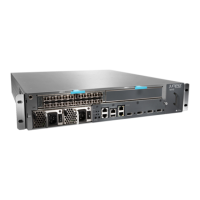TX Matrix Plus Router Overview
The TX Matrix Plus router is the central switching and routing element that interconnects
up to four T1600 chassis into a single routing entity with 32 slots and a sustainable
throughput rate of up to 6.4 Tbps (7.68 billion pps). With the TX Matrix Plus router,
operators can build systems containing up to four line-card chassis for a total of up to
320/640 10GbE (line rate/oversubscribed) ports, 64 40 Gbps ports, or 32 100GbE ports.
Using the virtualization capabilities of the JCS Control System, this available resource
can be partitioned into aggregation or edge routing, or into the support of virtual service
networks for advanced partitioned services such as video, mobile, and all corporate
traffic. (See Figure 19 on page 44 and Figure 20 on page 45.)
The routing matrix multichassis architecture provides scalable growth for aggregation
and core services for voice, video, and data networks. It provides a flexible and
cost-effective means to simplify large point-of-presence (POP) and central office
environments. The routing matrix delivers high availability services from tunnel services,
ATM, DS3, OC3/STM1, OC12/STM4, Gigabit Ethernet, 10-Gigabit Ethernet, OC48/STM16,
OC192/STM64, and other high-speed interfaces. The routing matrix leverages the
intelligent virtual services capabilities of Junos OS, which enable you to create multiple
application-specific logical networks over a single physical topology. This gives you the
ability to virtually separate traffic types that require unique network attributes—such as
ATM or high-priority voice over IP (VoIP) and third-generation (3G) mobile traffic—from
bulk transit IP traffic.
The router architecture cleanly separates control operations from packet-forwarding
operations. This design eliminates processing and traffic bottlenecks, permitting the
routing matrix to achieve terabit performance levels. Control operations in the routing
matrix are performed by the host subsystem, which runs Junos OS to handle traffic
engineering and configuration management. High availability, interchassis communications
are provided by an Ethernet LAN that interconnects the host subsystems in the TX Matrix
Plus router and the line-card chassis (LCC) routers.
A TX Matrix Plus router is also referred to as a switch-fabric chassis (SFC). The
command-line interface (CLI) uses sfc to refer to the TX Matrix Plus router. You manage
the routing matrix by connecting the TXP-CB in the TX Matrix Plus router to external
management devices.
43Copyright © 2012, Juniper Networks, Inc.
Chapter 2: T Series Core Routers

